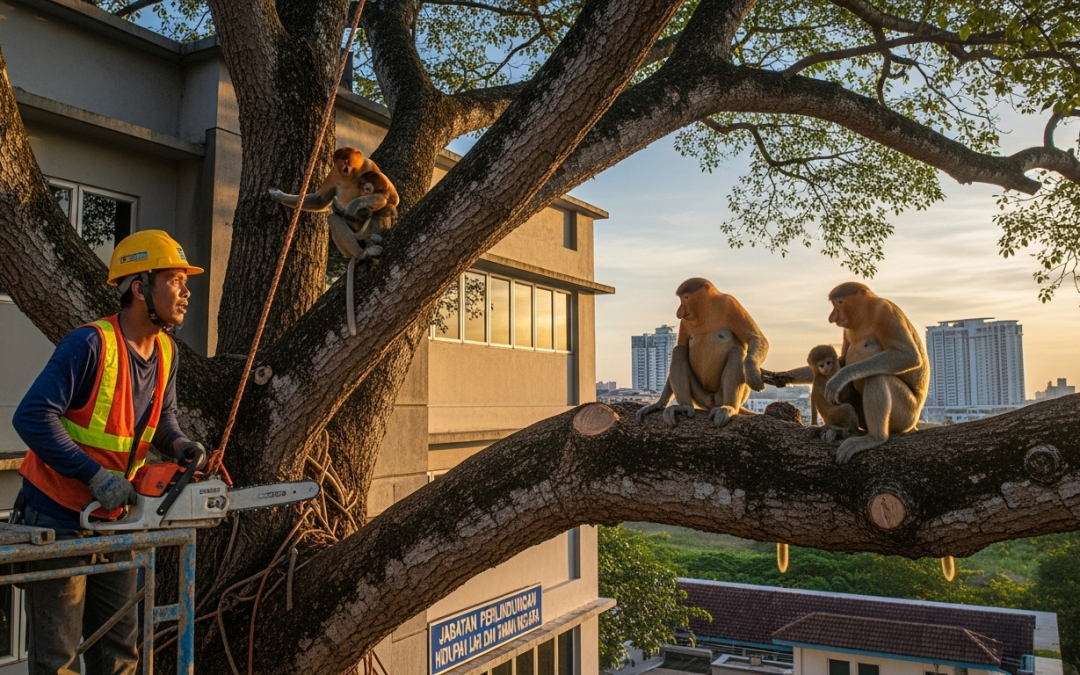In the verdant landscapes of Malaysia, our gardens and parks represent more than mere green spaces—they are vibrant ecosystems brimming with life. A fully grown tree in your yard serves not only as a source of shade or an attractive view; it functions as a crucial habitat for a variety of local wildlife.
The difficulty arises when a tree requires maintenance or removal, whether for safety, development, or aesthetic purposes. The issue transcends gardening; it evolves into an ethical and, in many instances, legal quandary: “Should we fell this tree, aware that it provides shelter for animals?”
The Tree as a Thriving Malaysian Ecosystem
Before you begin using a saw, it is essential to recognize the potential inhabitants of your tree. Although we typically associate trees with birds, many other “residents” can be found in our urban Malaysian trees.
The Busy Bees and Birds: From the graceful Yellow-vented Bulbul (Pycnonotus goiavier) constructing its nest within a bush to the Giant Honeybee (Apis dorsata) creating its large, exposed comb high on a branch, these are the most apparent inhabitants.
The Playful Mammals: The common Plantain Squirrel (Callosciurus notatus) is a well-known sight, darting up and down tree trunks. It depends on trees for nourishment and shelter, crafting nests referred to as “dreys” from leaves and twigs. A less frequently observed but equally prevalent resident is the nocturnal Common Palm Civet (Paradoxurus hermaphroditus), which utilizes tree cavities as a daytime refuge.
The Unseen Residents: Even trees that appear empty can conceal life. Various geckos and skinks take refuge in bark crevices, while snakes such as the Paradise Tree Snake (Chrysopelea paradisi) may be coiled within the canopy. In urban outskirts, one might even encounter groups of Long-tailed Macaques (Macaca fascicularis) utilizing trees as a thoroughfare.
The Core Question: To Cut or Not to Cut?
This decision should be influenced by two primary considerations: safety and legality. In Malaysia, the Wildlife Conservation Act 2010 (Act 716) establishes a definitive legal framework. It is considered a violation to kill, harm, or even interfere with the nests, dens, or offspring of any protected wildlife.
Follow this simple decision-making process before you begin any work:
Step 1: Is the Tree an Immediate and Severe Danger?
If YES: This is the sole circumstance in which immediate action may be necessary. Should the tree be decaying, damaged by a storm, or represent a direct risk to human life or property, the matter requires professional intervention. It is essential to consult a certified arborist. In the event that a protected animal is present, they will assist you in contacting the Department of Wildlife and National Parks (PERHILITAN). Do not attempt to remove the animal or its habitat on your own.
- If NO: The tree does not pose a danger. Move on to Step 2.
Step 2: Is the “Home” Currently Occupied?
Perform a comprehensive inspection. Walk around the tree and examine closely for any signs of life. Listen for sounds and observe for animal activity, such as frequent entries and exits from a specific cavity or nest. Keep in mind that nesting season typically occurs in the early part of the year in Malaysia, although this can vary.
- If YES: The response is a clear NO; do not proceed with cutting. The most responsible and legally compliant action is to delay the work. Exercise patience and wait until the animals have safely vacated the area. The waiting period is generally a few weeks, but may extend longer for certain species.
- If NO: The nest or den seems to be unoccupied. It is usually safe to continue with your gardening or cutting plans.
Part 3: Practical Steps for Responsible Tree Care
When you have concluded that felling the tree is not the appropriate decision, here are some alternatives that still enable you to manage your garden effectively:
Targeted Pruning: Rather than opting for complete removal, consult a professional arborist to carry out targeted pruning. This approach can address specific issues (e.g., branches in contact with a roof) without disturbing a nest or compromising the entire tree.
Habitat Coexistence: In secure areas of your garden, consider retaining certain old or dead branches. These “snags” are crucial for wildlife, offering nourishment for insects and providing shelter for cavity-nesting birds.
Consult the Experts: If you are uncertain, reach out to your local state office of PERHILITAN. They are the authoritative body on wildlife conservation and can offer guidance, advice, and support for intricate situations.
Conclusion: Finding Balance and Respect
Our connection with nature revolves around achieving harmony. By recognizing that a tree serves as a habitat, honoring the lives it shelters, and adhering to the appropriate legal and ethical guidelines, we play a part in fostering a healthier, more dynamic Malaysia. Responsible tree management extends beyond merely cultivating our gardens—it involves coexisting with our wild neighbors and guaranteeing that our urban environments flourish as a sanctuary for everyone.

